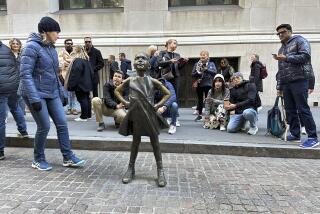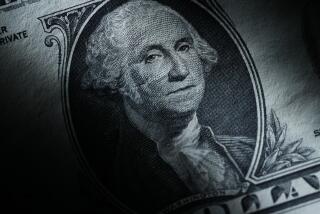CDs Gain New Currency in Today’s Turbulent Market
- Share via
Savers are now finding that the lowly certificate of deposit is gaining new cachet as stock markets swoon and many bond funds struggle. And right now may be a good time to lock in CDs’ comparatively high yields.
CDs’ status was enhanced even further Thursday, as yields on government Treasuries tumbled again.
The 30-year Treasury bond fell to a record-low yield of 5.34%, while one-year Treasuries now yield 4.98%--the lowest level since February 1996.
In fact, some observers say investors may have a brief window to lock in CDs’ higher rates on money that won’t be needed immediately.
“With the top-yielding CDs, investors can get more than they can get from the top money market funds,” said Karen Christie, research director for Bank Rate Monitor, a firm that tracks CD rates. “But if the Fed lowers interest rates, those top CD yields could come down too.”
For years, financial planners and money managers steered their customers away from CDs, generally for the higher yields and greater liquidity of money market mutual funds.
But over the last few months, the gap between money market funds and the typical CD has narrowed. Although the average money market fund still pays more than the average short-term CD, yield hunters can easily find one-year CDs that pay 6%--more than the 5.84% or so paid by top-yielding money market funds--with just a few phone calls or mouse clicks.
The Times runs a list of high-yielding CDs in its Sunday business section, and companies such as Bank Rate Monitor keep running tabs on CDs on their Web sites. Cross Country Bank in Delaware, for example, offers a one-year CD with a 6% yield on a $5,000 minimum deposit, and Southern Pacific Bank in California has a six-month CD at 5.86%.
*
Investors who want to keep their money close by should investigate rates offered by local credit unions, which typically pay higher rates than banks, Christie said. Lockheed Federal Credit Union and Hughes Aircraft Employees Federal Credit Union recently offered 5.8% one-year CDs.
Most planners still favor money market funds and short-term bond funds for emergency money or cash that’s temporarily on the sidelines, waiting for an opportunity to be invested in the stock market. Money markets and bond funds offer instant access to cash, while breaking into a CD means incurring penalties and delays.
But planners say a staggered portfolio of CDs or Treasury bills that mature at different times can make sense for investors who don’t need that kind of instant liquidity. Staggered portfolios allow investors to take advantage if rates go higher, since they can use proceeds from a maturing CD to buy a higher-rate version, while locking in most of the portfolio’s yields if rates go lower.
CD rates have remained relatively stable as yields on Treasury bills have tumbled in recent weeks. The one-year Treasury bill yield has slid from 5.37% on July 31 to 4.98% now, while the average national yield on one-year CDs has only slipped from 4.99% on July 31 to 4.92% now.
Mark Spangler, a Seattle planner and past chairman of the fee-only National Assn. of Personal Financial Advisors, has favored using Treasury bills for short-term cash needs, since Treasuries offer a significant tax break, particularly for wealthy clients in high-tax states, because they are exempt from state and local taxes. But as yields continue to fall, Spangler said he may look for alternatives.
“Anything government is going to drop like a rock,” Spangler said.
Treasury yields have fallen in part because investors are flocking to safer investments to escape turmoil in domestic and international markets. A reduced deficit is also limiting the supply of Treasury bonds, since the U.S. government doesn’t need to borrow as much. The combination of low supply, high demand and benign inflation is driving Treasury yields to new lows.
At the same time, a relatively robust U.S. economy means banks need more depositor money so they can make more loans, and that is leading to higher CD rates in many areas.
Donald Chou, a San Juan Capistrano financial planner, constructs a laddered CD portfolio as part of an emergency fund for some of his clients. The portfolio is designed so that a CD matures every month.
“They can charge anything that comes up on a credit card and have 30 days to pay it off” with CD proceeds, Chou said.
CDs tend to be most popular among clients who want guarantees offered by FDIC insurance, Chou said.
Money market funds come with no guarantees. Not only are they not FDIC-insured, but their rates can change quickly. If short-term interest rates fall in the near future, for example, money market fund rates will probably fall as well. A CD investor who locks in a one-year rate won’t suffer if banks later lower CD rates, as they probably will if other rates fall, Christie said.
The lack of guarantees hasn’t stopped money market funds from attracting record in-flows in recent weeks. IBC Financial Data reports investors added a record $13.3 billion to all types of money funds in the last week. But economists and market observers say a rate drop grows more likely as international conditions worsen and the U.S. economy slows.
Financial planners are quick to point out that long-term investors who can afford to ride out the markets’ ups and downs are still better off in stocks and bonds than in cash. But many predict cash and CDs will draw more converts if the markets continue to falter.
“If CD returns stay marginally better and if the market doesn’t come back up, that’s where you’re going to see people turning to them [CDs] in droves,” said Harold Evensky, a financial planner from Coral Gables, Fla.
(BEGIN TEXT OF INFOBOX / INFOGRAPHIC)
Safety First
Certificate of deposits are now often the best spot to maximize often the best spot to maximize yields on short-term savings vehicles and current interest rates:
1-year CD high rate: 6.00%
Money market fund high rate: 5.84%
Money market fund average rate: 5.03%
1-year Treasury bill: 4.98%
1-year CD averge rate: 4.92%
Source: Bank Rate Monitor, IBC Financial Network
Safety Pays
Deciding where to put your emergency funds or short-term savings? The gap between money funds and certificates of deposit has narrowed, with CDs often offering higher interest rates. The following examples assume someone in the 28% federal tax bracket and 7% state tax bracket investing $5,000 for one year. Money market rates can change daily, but the chart assumes they remain the same for a year.
*--*
Investment Yield Interest Earned 1-year CD (highest rate) 6.00% $300.00 Money market fund (highest rate) 5.84 292.00 1-year Treasury bill 4.98 $249.00 Tax-free money market (highest rate) 3.41 170.50 Money market fund (average rate) 5.03 251.50 1-year CD (average rate) 4.92 246.00 Tax-free money market (average rate) 2.82 141.00
Investment Net After Tax* 1-year CD (highest rate) $195.00 Money market fund (highest rate) 189.80 1-year Treasury bill 179.28 Tax-free money market (highest rate) 170.50 Money market fund (average rate) 163.48 1-year CD (average rate) 159.90 Tax-free money market (average rate) 141.00
*--*
Note: CD rate calculations assume simple interest with no interest withdrawals. High-rate CDs may be only available at certain banks or credit unions or during promotions.
*Results vary by tax bracket.
Sources: Bank Rate Monitor and IBC Financial Network
More to Read
Inside the business of entertainment
The Wide Shot brings you news, analysis and insights on everything from streaming wars to production — and what it all means for the future.
You may occasionally receive promotional content from the Los Angeles Times.










